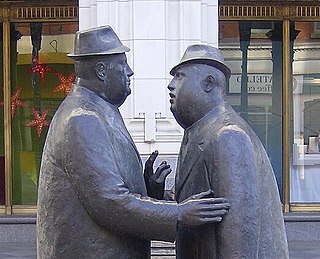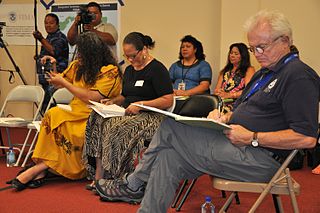Related Research Articles

Communication is usually understood to be the transmission of information. Its precise definition is disputed and there are disagreements about whether unintentional or failed transmissions are included and whether communication not only transmits meaning but also creates it. Models of communication are simplified overviews of its main components and their interactions. Many models include the idea that a source uses a coding system to express information in the form of a message. The message is sent through a channel to a receiver who has to decode it to understand it. The main field of inquiry investigating communication is called communication studies.

Public relations (PR) is the practice of managing and disseminating information from an individual or an organization to the public in order to influence their perception. Public relations and publicity differ in that PR is controlled internally, whereas publicity is not controlled and contributed by external parties. Public relations may include an organization or individual gaining exposure to their audiences using topics of public interest and news items that do not require direct payment. The exposure is mostly media-based, and this differentiates it from advertising as a form of marketing communications. Public relations aims to create or obtain coverage for clients for free, also known as earned media, rather than paying for marketing or advertising also known as paid media. But in the early 21st century, advertising is also a part of broader PR activities.
Human communication, or anthroposemiotics, is a field of study dedicated to understanding how humans communicate. Humans' ability to communicate with one another would not be possible without an understanding of what we are referencing or thinking about. Because humans are unable to fully understand one another's perspective, there needs to be a creation of commonality through a shared mindset or viewpoint. The field of communication is very diverse, as there are multiple layers of what communication is and how we use its different features as human beings.
Within the realm of communication studies, organizational communication is a field of study surrounding all areas of communication and information flow that contribute to the functioning of an organization. Organizational communication is constantly evolving and as a result, the scope of organizations included in this field of research have also shifted over time. Now both traditionally profitable companies, as well as NGO's and non-profit organizations, are points of interest for scholars focused on the field of organizational communication. Organizations are formed and sustained through continuous communication between members of the organization and both internal and external sub-groups who possess shared objectives for the organization. The flow of communication encompasses internal and external stakeholders and can be formal or informal.
A technical writer is a professional information communicator whose task is to transfer information between two or more parties, through any medium that best facilitates the transfer and comprehension of the information. Technical writers research and create information through a variety of delivery media. Example types of information include online help, manuals, white papers, design specifications, project plans, and software test plans. With the rise of e-learning, technical writers are increasingly becoming involved with creating online training material.

Communication studies or communication science is an academic discipline that deals with processes of human communication and behavior, patterns of communication in interpersonal relationships, social interactions and communication in different cultures. Communication is commonly defined as giving, receiving or exchanging ideas, information, signals or messages through appropriate media, enabling individuals or groups to persuade, to seek information, to give information or to express emotions effectively. Communication studies is a social science that uses various methods of empirical investigation and critical analysis to develop a body of knowledge that encompasses a range of topics, from face-to-face conversation at a level of individual agency and interaction to social and cultural communication systems at a macro level.

A memorandum, also known as a briefing note, is a written message that is typically used in a professional setting. Commonly abbreviated memo, these messages are usually brief and are designed to be easily and quickly understood. Memos can thus communicate important information efficiently in order to make dynamic and effective changes.

Business process re-engineering (BPR) is a business management strategy originally pioneered in the early 1990s, focusing on the analysis and design of workflows and business processes within an organization. BPR aims to help organizations fundamentally rethink how they do their work in order to improve customer service, cut operational costs, and become world-class competitors.

Internal communications (IC) is the function responsible for effective communications among participants within an organization. The scope of the function varies by organization and practitioner, from producing and delivering messages and campaigns on behalf of management, to facilitating two-way dialogue and developing the communication skills of the organization's participants.
Business communication is communication that is intended to help a business achieve a fundamental goal, through information sharing between employees as well as people outside the company. It includes the process of creating, sharing, listening, and understanding messages between different groups of people through written and verbal formats. The way that people communicate and operate within a business is very vital to how successful the company will be in the business world. Business communication occurs internally, employee-to-employee, or externally, business-to-business or business-to-consumer. This internal and external communication can happen through verbal or non-verbal communication methods. Often these internal and external forms of communication come with barriers, which can prevent the receiver from understanding the information sent by the sender.

The Office of Legal Counsel (OLC) is an office in the United States Department of Justice that assists the Attorney General's position as legal adviser to the President and all executive branch agencies. It drafts legal opinions of the Attorney General and provides its own written opinions and other advice in response to requests from the Counsel to the President, the various agencies of the Executive Branch, and other components of the Department of Justice. The Office reviews and comments on the constitutionality of pending legislation. The office reviews any executive orders and substantive proclamations for legality if the President proposes them. All proposed orders of the Attorney General and regulations that require the Attorney General's approval are reviewed. It also performs a variety of special assignments referred by the Attorney General or the Deputy Attorney General.
Professional writing is writing for reward or as a profession; as a product or object, professional writing is any form of written communication produced in a workplace environment or context that enables employees to, for example, communicate effectively among themselves, help leadership make informed decisions, advise clients, comply with federal, state, or local regulatory bodies, bid for contracts, etc. For example, in a business office, a memorandum can be used to provide a solution to a problem, make a suggestion, or convey information. Other forms of professional writing commonly generated in the workplace include email, letters, reports, and instructions. In seeking to inform, persuade, instruct, stimulate debate, or encourage action from recipients, skilled professional writers make adjustments to different degrees of shared context, e.g., from a relatively accessible style useful for unsolicited contact letter to prospective clients to a technical report that relies on a highly specialized in-house vocabulary.
Corporate communication(s) is a set of activities involved in managing and orchestrating all internal and external communications aimed at creating a favourable point of view among stakeholders on which the company depends. It is the messages issued by a corporate organization, body or institute to its audiences, such as employees, media, channel partners and the general public. Organizations aim to communicate the same message to all its stakeholders, to transmit coherence, credibility and ethics.
Lateral communication is "the exchange, imparting or sharing of information, ideas or feelings between people within a community, peer groups, departments or units of an organization who are at or about the same hierarchical level as each other for the purpose of coordinating activities, efforts or fulfilling a common purpose or goal
Communications training or communication skills training refers to various types of training to develop necessary skills for communication. Effective communication is vital for the success in various situations. Individuals undergo communications training to develop and improve communication skills related to various roles in organizations. Good executive communication helps garner trust between bosses and employees and between team leaders and their direct reports.
Ethical issues of business communication is the way by which individuals or groups of people exchange information between them.From end-to-end the process, effective communicators try as clearly and accurately to pass on their ideas, intentions and, objectives to their receiver. Communication is successful only when both the sender and the receiver understand the same information.Nowadays business world, effective communication skills are necessary due to the highly informational and technological era,Which has made it easier for exchanging of information between the parties.
Workplace communication is the process of exchanging information and wisdom, both verbal and non-verbal between one person/group and another person/group within an organization. It includes e-mails, text messages, notes, calls, etc. Effective communication is critical in getting the job done, as well as building a sense of trust and increasing the productivity of employees. These may have different cultures and backgrounds, and can be used to different norms. To unite activities of all employees and restrain from any missed deadline or activity that could affect the company negatively, communication is crucial. Effective workplace communication ensures that all the organizational objectives are achieved. Workplace communication is tremendously important to organizations because it increases productivity and efficiency. Ineffective workplace communication leads to communication gaps between employees, which causes confusion, wastes time, and reduces productivity. Misunderstandings that cause friction between people can be avoided by effective workplace communication. Effective communication, also called open communication, prevents barriers from forming among individuals within companies that might impede progress in striving to reach a common goal. For businesses to function as desired, managers and lower-level employees must be able to interact clearly and effectively with each other through verbal communication and non-verbal communication to achieve specific business goals. Effective communication with clients plays a vital role in development of an organization and success of any business. When communicating, nonverbal communication must also be taken into consideration. How a person delivers a message has a lot of influence on the meaning of this one.
Business correspondence means the exchange of information in a written format for the process of business activities. Business correspondence can take place between organizations, within organizations or between the customers and the organization. The correspondence refers to the written communication between persons. Hence oral communication or face to face communication is not a business correspondence.

"Google's Ideological Echo Chamber", commonly referred to as the Google memo, is an internal memo, dated July 2017, by US-based Google engineer James Damore about Google's culture and diversity policies. The memo and Google's subsequent firing of Damore in August 2017 became a subject of interest for the media. Damore's arguments received both praise and criticism from media outlets, scientists, academics and others.

David Kenneth Berlo was an American communications theorist. He taught at Michigan State University and later served as president of Illinois State University.
References
- ↑ Szewczak, Edward J.; Snodgrass, Coral R. (2002). Managing the human side of information technology : challenges and solutions. Hershey, PA: Idea Group Publishing. ISBN 978-1-930708-32-7.
- ↑ Hein, Lauren Vicker, Ron (1999). The fast forward MBA in business communication. New York: John Wiley & Sons. ISBN 978-0-471-32731-8.
{{cite book}}: CS1 maint: multiple names: authors list (link) - ↑ Roman, Kenneth; Raphaelson, Joel (2000). Writing that works : how to communicate effectively in business (3rd ed., rev. and updated. ed.). New York: HarperCollins. ISBN 978-0-06-095643-1.
- ↑ Roman, Kenneth; Raphaelson, Joel (2000). Writing that works : how to communicate effectively in business (3rd ed., rev. and updated. ed.). New York: HarperCollins. ISBN 978-0-06-095643-1.